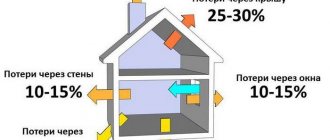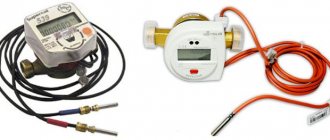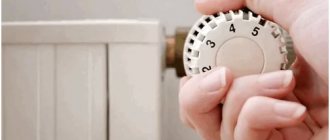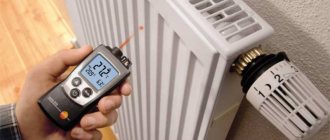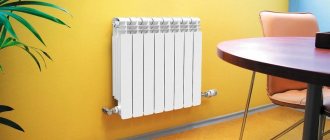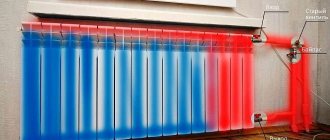Installing a heating meter in your apartment is the best solution for saving your family budget. The installation of the device is carried out in accordance with a certain technology, so the work must be carried out by specialized organizations.
To obtain benefits, it is necessary to focus on the adopted regulations, on the basis of which the flow meter is recognized as being put into operation, and the readings of the device are accepted for calculating the monthly payment.
Why do you need a heating meter?
Probably everyone has encountered problems with central heating batteries. Modern houses are designed with autonomous heating, so that the consumption is calculated for each apartment separately. People who live in older houses do not have such a prerogative. Sometimes they have to suffer because utility services want to save money and turn up the heating, as a result, the temperature in the house drops, and the bills come in sky high, the question arises: what are we paying for then?
Let's consider the main problems of centralized heating:
- The used cubic meters of heat are distributed to all apartments, taking into account data on the area of the apartment from those. passports, but redesigned, enlarged apartments are not taken into account. So you may end up paying more for luckier neighbors.
- Significantly less heat enters the batteries than comes out of the boiler room. In fact, the cost of heating includes heat that does not even enter your apartment.
- The plumbers turn up the heating, you freeze or use additional heating methods (for which you also pay), and the bills come the same.
Important! Considering the listed disadvantages of central heating, one can understand why so many people want to install individual meters. About 30% of the heat we pay for does not reach the apartment.
By installing the device in an apartment, we can check how much heat is supplied and pay only for it. If you don't have enough heating power, you will at least pay an adequate price.
Is it possible to install a heat meter in an apartment?
The question: is it allowed to install heat meters in an apartment still remains relevant.
The World Wide Web gives diametrically opposed answers. Perhaps the utility services themselves are misleading people, since they do not really benefit from such modernization. However, we cannot be fooled so easily; after reviewing the legislation, we made an unambiguous conclusion: it is possible to establish, but there are several nuances.
Please note that installing a heat meter in an apartment yourself is not only prohibited, but also very dangerous. Outside interference in the heating system can result in an accident, and if everything goes smoothly, then, in any case, it will not be accepted by the heating service.
If you decide to install such a meter, then you need to do everything according to the rules.
When installation is not possible
There is no legislation prohibiting the installation of your own meter, but there are cases when technically installing it simply does not make sense. This situation is possible in very old houses, where changing the heating system is impossible or not profitable.
Basically, the problem lies in the wiring of the heating system. It comes in two types:
- Vertical system. Heat passes through all floors up and then back. In this case, there are usually several risers per apartment, and a meter will have to be installed on each of them, which is very expensive. Most often, such heating is installed in Khrushchev-era buildings.
- Horizontal - has two pipes, heat enters through one, and through the other it goes out with one riser to the apartment. Therefore, installing a meter will not be a problem.
To be absolutely sure whether a heat meter can be installed in an apartment, contact a specialist. They will conduct an inspection and tell you how effective the modernization will be and how much it will cost to maintain this system.
Heat meters in the legislation of the Russian Federation
It is important to note that in the Russian Federation there is a law that obliges the installation of heat meters in an apartment building at the expense of the residents. If this is not done, then you will have to pay a tariff with a coefficient of 1.5, if not more.
In this case, it does not matter whether you have an individual meter for your apartment; its readings will not be taken into account. Therefore, first make sure that your house has a common meter, and then install an individual one according to the procedure established by law.
Who should pay how much for heating?
It turns out that in houses that were put into operation in 2012 and later, heat meters should be installed in each apartment by default - developers are required to install them.
Moreover, if the design documentation for an apartment building was developed before 2012 and did not include the installation of an IPU for thermal energy, and the house was built and put into operation later, then the developer has no obligation to install an IPU, this is court practice.
When overhauling in-house engineering heat supply systems since 2012, if technically possible, houses must also be equipped with heat energy meters. However, the capital repair program does not provide for this type of work (LC RF, Article 166).
Owners of apartments in houses equipped with metering devices must pay according to their individual readings, even if one of the neighbors dismantled the meters in their apartment. Thermal energy consumed, provided for general house needs, must also be paid for by all owners of apartment buildings, regardless of the presence or absence of IPU.
Residents who have removed their meters without permission must pay for heating according to established standards. This decision was made by the Constitutional Court of the Russian Federation.
In those houses that were put into operation before 2012, where major repairs have not yet been carried out or have been carried out, but there is no technical possibility of installing building-wide heat meters, heating fees will be charged according to the standards.
If it is technically possible to install distributors, then in order to calculate heating costs based on the readings of the distributors, you need to equip at least 50% of the apartments in the house with them (in this case, at least one apartment must have a heat control unit installed).
The obligation to pay for heating services, which is used for general house needs, always remains.
If there is a building-wide heat energy meter, but there is not a single distributor and not a single heat control unit, the total readings will be divided among all apartments.
Formulas for calculating heating fees can be found in Appendix No. 2 to the “Rules for the provision of utility services to owners and users of premises in apartment buildings and residential buildings,” approved by Decree of the Government of the Russian Federation dated May 6, 2011 No. 354.
The procedure for legal installation of a heat meter
The legislation does not prescribe mandatory standards for heating meters per apartment. But the law specifies the procedure that must be followed to install a heat meter:
- Write a statement to the organization that supplies heat to your home. Specialists will check the possibility of carrying out this procedure from a technical point of view. After checking, if everything is fine, then you will receive technical support. conditions that specify the nuances of developing and installing a meter in your apartment.
- If you have created a condominium association, then its chairman needs to provide a copy of the application and clarify the process of installing the heat meter.
- Find an organization that develops projects for installing heat meters, check that they have all the documents confirming their qualifications in this matter.
- Approve the project from the company that supplies heat, then contact the company that installs heat meters.
- The installed equipment must be shown to the heat supply company and an agreement must be signed with them. A specialist from this company will service the heat meter, but at your expense. From now on, you will pay for the actual heat you use.
For reference: the meter will count the heat consumption only for your apartment, but you will be required to pay part of the amount for heating the non-residential premises of the house, along with other residents.
How to convince neighbors to install heat meters
If you install meters in all apartments in apartment buildings, the bills may be reduced compared to those calculated according to the standards. But how can we encourage our neighbors to take such a step?
At the general meeting of owners, make a decision to install heat meters in apartments at the expense of the owners.
To make a decision, you need to get 2/3 of the votes of the owners of the total number of votes.
The advantage is that installation work can be completed quickly. The difficulty is that the owners may not agree, because purchasing and installing meters will require considerable expenses. Before the meeting, you can contact the management company (MC) / homeowners association (HOA) - depending on who manages the house - to carry out “promotional and explanatory work” about the benefits of meters and saving resources. This is in the interests of the management company (HOA) itself; it should make efforts in the direction of energy saving.
In Moscow, prices for apartment heat meters start at 6,000 rubles. The cost of services for the installation of turnkey meters with the preparation of a project for individual heat metering and the development of technical documentation is from 12,000 rubles and above (this includes the cost of the necessary components and the meters themselves). Companies that install meters claim that the installation of heat meters pays for itself in 2 heating seasons. If you decide to install meters in all apartments, you can purchase meters at a wholesale price and receive a discount on the installation service.
It is possible at a general meeting to decide on the installation of heating cost allocators.
Types of heat meters for heating
If you have already decided to install a heating meter in your apartment and have checked all the technical capabilities of the house, then it’s time to think about which device to buy. Heat meters come in several types; they differ in price, quality, durability and temperature measurement method, but functionally they perform the same role.
Mechanical heat meters
Let's start with the simplest and most budget option - a mechanical heat meter. This option is the cheapest, but also the most short-lived. It does not tolerate dirt, temperature changes, or rust well, so in just a couple of years you will have to buy a new one. The design of a mechanical meter is very simple: a gear rotates inside and moves numbers that show how much heat your apartment consumes. The system is almost identical to the light meter.
Ultrasonic meters
They more accurately measure the amount of heat received. Such a device will last a very long time if you install a special filter so that only water purified from debris passes through the meter. Its price is higher than that of a mechanical counter. Although if you calculate how much budget money you will save on purchasing and repairing a device, the issue is moot. Heat suppliers often insist on choosing just such a meter, because its measurements cannot be influenced from the outside.
Vortex heat meters
This type of heat meter calculates the wasted heat using obstacles that are created during water circulation (vortexes). This universal device is suitable for horizontal and vertical heating systems and shows accurate data despite various deposits in the pipes. When choosing a vortex heat meter, you need to take into account the size of the pipe to which the device will be attached.
Electromagnetic meters
When water moves through the pipes and delivers heat to our apartment, a certain amount of current is generated, which is read by the electromagnetic meter. Electromagnetic meters are cheaper, so they are very popular. This is a kind of improved version of a mechanical meter.
Poor quality water, as well as improper installation of the device, can lead to rapid breakdown of the device. This option is used both for the whole house and as an individual meter for an apartment.
Features of the main types of meters
A group of individual heat energy metering devices is designed to work in heating networks with a pipe channel diameter of 15-20 mm and a coolant volume in the range of 0.6-2.5 cubic meters per hour.
Heat meters and heat distributors perform calculations of consumed thermal energy independently, with data displayed on an electronic display.
Horizontal distribution of heating pipes allows you to install the heat meter covertly, in a communication niche or shaft
The computing module of the device determines the amount of heat consumption for a given period of time (hour, day or month), storing and accumulating this information in the device’s memory for 12-36 months.
The most convenient way is to install a non-volatile heating meter (i.e. with an additional power source - a battery).
Depending on the heat meter model, its measurement values are displayed as kilowatts per hour, megawatts per hour, gigajoules or gigacalories. Management and other utility companies require heat readings in Gcal.
To convert to gigacalories, you must apply the appropriate conversion formula. For example, for kilowatts per hour - multiply the value by a factor of 0.0008598.
Each meter is a complex of several devices. Its kit may include temperature sensors, calculators for the volume of consumed thermal energy, as well as pressure, flow and coolant resistance transducers.
The exact configuration of the heat meter is set by the manufacturer for a specific model.
It is convenient to install a heat meter at the final stage of installing an apartment heating system
Depending on the principle of accounting for consumed thermal energy, heat meters are equipped with an ultrasonic or mechanical (tachometer) flow meter.
Models of devices with other types of flow meters (for example, vortex or electromagnetic) are also available, but they are not widely used. Heat meters are designed to collect information on heat consumption exclusively on the horizontal distribution of the heating circuit.
A separate group of heat meters are calculators and heat distributors that do not require insertion into the heating circuit. These devices are used to calculate the heat costs of heating radiators for any heating circuit diagram.
Type #1 - mechanical version of the flow meter
The simplest type of design, therefore the cheapest (about 9,000-10,000 rubles) is a device with two wired temperature sensors, a water meter and an electronic computer unit.
The main working element of the meter is a part (impeller, turbine or screw) that rotates as coolant passes through the device. The number of rotations determines the volume of coolant passing through the meter.
The installation procedure for a heat meter is seemingly simple, but the efficiency of the device depends on its quality.
Contact thermometers are built into the supply and return pipes of the heating circuit of the apartment. The first thermometer is placed in the meter, in a special socket.
The second is installed on the return pipeline, in a ball valve of a special design (with a socket) or in a tee equipped with a sleeve for a thermometer.
Advantages of mechanical heat meters:
- cost about 8,000 rubles;
- the design is simple and reliable;
- no external power supply required;
I am attracted by the fairly correct stability of the indicators and the permissibility of installation in a horizontal or vertical position.
Disadvantages of mechanical type heat meters:
- Guaranteed operation period is no more than 4-5 years - verification is required every 4 years;
- high wear of rotating parts - however, all mechanical meters are repaired for little money;
- increase in pressure - the rotating element increases the pressure in the heating circuit;
- susceptibility to water hammer;
- high need for the actual coolant flow rate in the heating system to match the nominal flow rate set by the manufacturer.
It is mandatory to integrate a coarse magnetic mesh filter into the circuit in front of the mechanical heat meter. The device is extremely sensitive to the content of mechanical suspensions in the coolant volume!
Type #2 - ultrasonic heat meter
These devices determine the coolant flow using an ultrasonic signal emitted by the emitter and received by the receiver.
Both elements of the thermal ultrasonic meter are mounted on a horizontal heating pipe, and a certain distance is established between them.
The signal from the emitter follows the coolant flow and reaches the receiver after a period of time depending on the speed of the coolant in the heating circuit. Based on the time data, the coolant flow rate is determined.
It has no rotating elements. Therefore, the service life of such a heat meter is longer, and the heat data is accurate
Over 10 versions of ultrasonic flow meters are produced - frequency, Doppler, correlation, etc. In addition to performing basic tasks, an ultrasonic heat meter can have the function of adjusting the flow of coolant.
Advantages of ultrasonic heat meters for apartments:
- low price in the basic configuration - from 8,000 rubles. (domestic models);
- heat consumption data is displayed on the LCD display by pressing one button, which is convenient;
- operation of the device does not cause an increase in hydraulic pressure in the heating system;
Significant advantages include a long service life - more than 10 years (verification is necessary every 4 years) and power supply from a built-in battery.
The main disadvantage of ultrasonic heat meters is their sensitivity to the composition of the coolant. If it contains air bubbles and dirt particles (scale, scale, etc.), the device readings will be incorrect, and in the direction of increasing heat consumption.
For ultrasonic flow meters, there is one installation rule - the section of the pipeline in front of and after the device must be straight (the required total length of the straight section is more than a meter). Then the meter will provide correct data on heat consumption.
Type #3 - calculator and heat distributor
These devices measure the relative costs of thermal energy. Their design includes a thermal adapter and two temperature sensors.
Every three minutes, sensors measure temperatures on the surface of the heating radiator and in the room atmosphere, determining the difference. The collected information on heat consumption is summarized and displayed on the device screen.
There is no need to hide such a heat meter - it looks perfect in the modern interior of the room
Heat computers are programmed to operate on a specific type of heating radiator at the time of installation on it.
You may also be interested in information about the types of heating radiators and their characteristics, discussed in our other article.
All necessary coefficients and power indicators of the radiator are entered into the meter’s memory, which allows it to display data on heat consumption in kilowatt-hours.
The numbers indicated by heat distributors are displayed in conventional units. To convert them into kilowatt-hours, you should multiply the value of the readings by the rated power of the heating radiator and the coefficient corresponding to the type of heating battery.
The coefficient numbers are provided by the meter manufacturer based on the results of laboratory tests.
A heat spreader is similar to a heat calculator. They are distinguished by the inability of the distributor to count heat as kilowatts per hour. In general, the heat distributor is simpler than the computer
Calculators and heat distributors are placed to measure thermal energy on one heating radiator. Those. in an apartment where heating is metered using such devices, there should be as many meters as there are heating radiators.
Both types of meters are effective regardless of the residential heating scheme and the operating characteristics of the coolant used in the heating circuit.
Advantages of heat distributors and calculators:
- cost is about 2000-2500 rubles. - i.e. their installation is beneficial in small apartments equipped with five heating radiators or less (but more than 2);
- long service life without verification - 10 years;
- simple and quick installation on or next to the radiator housing;
- transfer of data from several heat meters via radio to a single controller that sums them up (the presence of a radio module depends on the device model);
A convincing argument in favor of installing such devices is the complete independence of measurement results from the quality of the coolant.
Disadvantages of apartment computers and heat distributors:
- the relative measurement error is up to 7-12% (the greatest error is characteristic of heat distributors), which is higher than that of “mortise” heat meters;
- Energy consumption data is correct if calculated from the results of measurements of several devices within the apartment. One computer is not able to correctly determine the heat consumption of the atmosphere from one radiator. Summary data across multiple instruments is required;
- Effective operation only on factory models of heating radiators. Those. any modifications to the factory configuration of the radiator when measuring heat with such heat meters are unacceptable.
The installation kit for installing a computer or heat distributor is selected according to the type of radiator on the body of which the meter will be installed.
Handicraft methods of installing the meter will worsen the quality of data collection. If there is no specialized mounting kit, it is more rational to mount the device next to the battery it serves.
General recommendations for choosing a device and its installation
We have already looked at the main types of heating meters, but which one is better to buy? In this matter, you can consult with experts who will prepare a project for installing a heating meter in an apartment. They will know what problems the device will encounter, and which one will work better under given conditions.
Also, the choice will depend on your financial capabilities. However, it is better to buy a durable ultrasonic device, although it is more expensive than one that will have to be replaced in a couple of years.
To install a heating meter in an apartment, you should contact a certified company. Experts do not recommend performing this procedure yourself - then problems will arise with the device being put into operation. Depending on the type and model of the device you buy, the installation procedure will differ; the easiest way to install an electromagnetic meter.
Important: after installing the meter, do not forget to register it with the heat energy supplier, otherwise it will be considered not working.
How to order the installation of a heat meter in Moscow
Only a licensed specialist in this field can install a heat meter. It will also help with the correct choice of metering device and eliminate the possibility of making mistakes. The price of installing a heat meter depends on the cost of the selected device, the number of additional components used and the complexity of the work performed. Installation of a heat meter in Moscow is completed in one working day, and the client is also provided with assistance in collecting the package of necessary documents for registering the metering device with the relevant institution.

